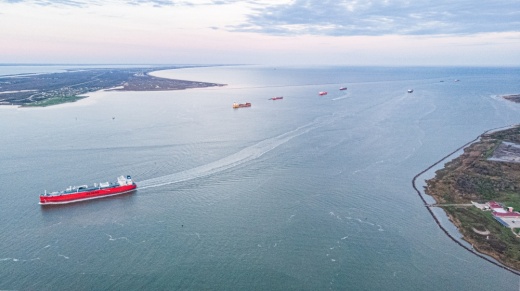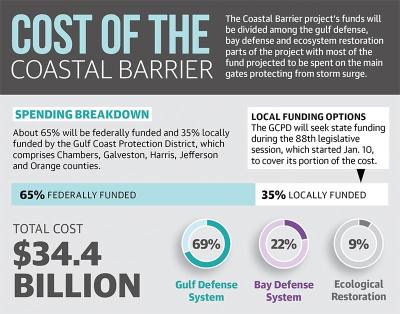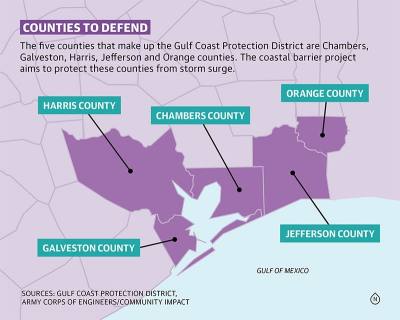The Coastal Texas Program reached a breakthrough in the U.S. Congress, where a bill containing the authorization for the construction of its various projects successfully passed. The $34.4 billion program aims to protect the Gulf Coast and parts of Harris and Galveston counties from catastrophic storm surge caused by natural disaster events, such as hurricanes, through the construction of a coastal barrier.
Nicole Sunstrum, executive director of the Gulf Coast Protection District, said the authorization for the project’s construction was rolled into the National Defense Authorization Act, a bill that is passed nearly every year by the government. The $858 billion spending package was signed by President Joe Biden on Dec. 23.
The Texas Coastal Spine Authorization Act was introduced July 26 by U.S. Sens. John Cornyn and Ted Cruz and U.S. Rep. Randy Weber, R-Friendswood. Weber called the Coastal Texas Program a matter of national security in a statement after the bill was signed into law.
“After years of work, I am proud that we have received the authorization for the Coastal Spine,” Weber said in a release. “But the work isn’t done. We will continue to work to secure funding for this imperative project as soon as possible since it’s a question of when—not if—another big storm barrels up the upper Texas Gulf Coast.”
The bill’s passage opened the door for the federal government to provide up to 65% of funding and may initiate environmental review design for the project this year.
Meanwhile, Project 11, or the $1 billion widening of the Houston Ship Channel, is almost completely funded by the port and federal and state governments. Charlie Jenkins, senior director of strategic programs at Port Houston, said the final portion of funds will come in two packages, one being an omnibus bill passed by the U.S. Congress in December for the U.S. Army Corps of Engineers, and the second coming from the fiscal year 2023-24 President’s Budget in February.
“If they get the remaining funding that’s needed, they’ll keep on schedule. If the project isn’t funded, then the project will start to slow down,” Jenkins said.
History of the coastal barrier
The Coastal Texas Program consists of more than 15 projects outlined by a six-year study led by the Army Corps of Engineers.
The program features a mixture of projects to reflect and absorb storm surge as a collective part of a coastal barrier, said Michael Braden, ACE Galveston District mega projects division chief. Projects protecting interior land include the Dickinson and Clear Lake gate systems and pump stations.
“The Coastal Texas Program is a series of dune and beach renourishment, gates, levees [and] pumps. ... It’s a multiple-line-of-defense, multiple-component system that works together,” Sunstrum said.
The various projects can be constructed sequentially as funding becomes available: Some sections of the program could take only a few years to finish, while others might only be completed after over a decade of construction, said Carlos Gomez, ACE deputy public affairs chief.
The timeline for the program is expected to take about 15-20 years, and initial steps such as construction contract bidding and final design could be taken in 2023 now that the NDAA is passed, Braden said.
“The scale is unprecedented,” Braden said. “It’s a massive comprehensive regional mitigation strategy to address catastrophic storm surge.”
Paying for the barrier
The Gulf Coast Protection District was founded in 2021 by the 87th Texas Legislature for the purpose of acting as the nonfederal sponsor of the Coastal Texas Program. The GCPD covers five counties by the Gulf Coast: Chambers, Galveston, Harris, Jefferson and Orange.
Sunstrum said the federal legislation authorizing the construction for the Coastal Texas Program will not include funding; the appropriation of funds is an additional step that Congress would need to approve in another bill.
“The more money that we get from the federal government, the faster the construction will be,” she said. “And that obviously will impact costs just because of time passing and ... rising cost of materials and all the other factors that go into inflation.”
The maximum requested cost of the overall project is about $34 billion, Sunstrum said. The original cost shown in the Coastal Texas Protection and Restoration Feasibility Study pitched to Congress in 2021 was $28.9 billion, but Sunstrum said this number increased over time due to inflation.
Bob Mitchell, president of the Bay Area Houston Economic Partnership and a member of the GCPD, said the federal government would be responsible for providing 65% of the funding for the protective elements of the project, while the GCPD would be responsible for the other 35%.
“We’re not asking for all the money at one time; we can’t build all of it at one time,” Mitchell said.
GCPD officials have previously mentioned to Community Impact the possibility of utilizing resilience bonds to produce the local funds to match federal spending. These bonds are a way for large companies along the coast to reimburse the cost for the project: Companies in the area with facilities that could be impacted by storm surge would benefit from the project and pay to support it. However, Sunstrum said there are no plans to issue bonds at this time and that the GCPD will seek state funding instead during the legislative session.
Sunstrum said she doubts Congress will appropriate the entire $34 billion up front, but she is happy to see strong bipartisan support of the issue.
“It kind of sells itself,” Sunstrum said. “All of these entities that are involved are really dedicated to seeing it through and seeing it implemented in the right way, and I think that’s a unique thing that’s really important for a project of this size.”
Widening the channel
The other major construction in the Bay Area that is not part of the Coastal Texas Program is Project 11, the expansion of the Houston Ship Channel, which is about 82% funded and under construction. However, the barrier will help safeguard the port.
“Right now, the Houston Ship Channel acts like a giant funnel for storm surge up into the city of Houston,” Braden said. “So this is critical to mitigate that risk all the way up into Houston.”
Project 11, or the 11th major project for the channel, will widen the channel by about 170 feet from 530 feet to 700 feet. This will allow for easier and safer two-way transit for the ever-growing vessels that pass through.
The federal government has already provided about $162.5 million for the $1 billion project so far, Jenkins said, and the port is going to spend $660 million through its own cash flows and revenue bonds, a type of bond in which repayment is guaranteed by the operating income of the entity.
Jenkins said the project, which started construction in May, is on track to be completed by 2025 if the remaining funding manages to make it through Congress in a timely manner.
Mitchell said the Port of Houston is a key economic driver of the entire country. It helps sustain nearly 1.35 million jobs in Texas and 3.2 million jobs nationwide, according to the Port of Houston website.
“We’re the No. 1 export port in the nation, everything from the coating on your capsules to the rubber on your tires,” Mitchell said.
Jenkins said the Coastal Texas Program would be key insurance for protecting not only the Gulf region and its residents, but also the port itself.
“I mean, heaven forbid that the Port of Houston and all the economic development and industry is harmed significantly from a storm; that can have a very dramatic impact on the United States economy,” Jenkins said.










